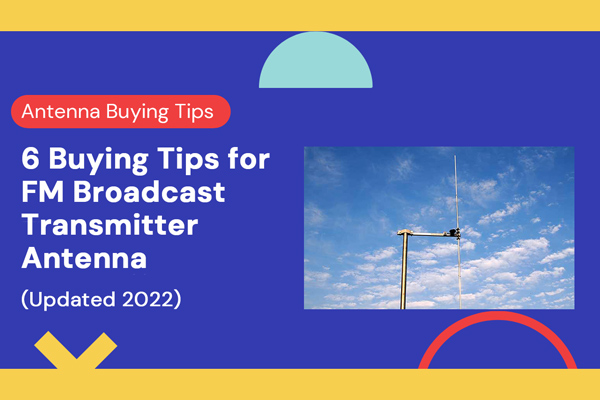
Hot tag
6 Buying Tips for FM Broadcast Transmitter Antenna

Both FM radio broadcasters and radio station owners pay great attention to the performance of FM broadcast transmitter antenna because it determines how many viewers can receive their radio stations.
If you are planning to build up an FM radio station, or you need to improve your FM radio signals to grow your business, or you're not satisfied with the performance of the FM radio antenna, it would be a good choice to replace an FM broadcast antenna with better performance. But do you know what you need to pay attention to when choosing an FM transmitter antenna?
With decades of experience in FM radio broadcasting, we will briefly introduce you to FM transmitter antenna and explain the 6 tips for buying the best FM transmitter antenna. Let's keep exploring!
What You Need to Know about FM Transmitter Antenna?
Simply learning about FM broadcast transmitter antenna can help you clarify the plan of improving FM radio signals because it is one of the most important audio broadcasting equipment besides FM broadcasting transmitters. Next, we will learn it from its applications and how does it work.
Applications - The FM transmitter antenna is used for broadcast FM signals that carrying many information, including sound, pictures, texts, etc. Therefore, the FM broadcast antenna can be used in radio broadcasters, FM radio stations, etc. They have different shapes and sizes in different broadcasting applications.
Working Methods - In an FM transmission system, the FM radio transmitter converts the audio signals into FM radio signals, then the FM transmitter antenna receives and broadcasts them in the form of radio signals. In addition, if you want to broadcast the signals in different directions and distances, you can combine them into FM antenna systems.
All in all, to improve the FM radio signals, a basic understanding of FM broadcast antenna is necessary, then you could be clear with how to improve the FM signals.
6 Tips for Buying the Best FM Broadcast Transmitter Antenna
It's not easy to have a full understanding of the FM broadcast antenna. Fortunately, FMUSER summarizes the most important 6 tips for buying the best FM transmitter antenna. Even if you're a novice, you can easily make it out.
Make Certain the Types
Making certain that what types of FM broadcast antenna you need can help you save the cost and make full use of it. For example, if you need to broadcast in a city, you should have a powerful directional antenna like FM yagi antenna to reduce the interference and block of the FM radio signals, while if you broadcast in rural area, you may just need an omnidirectional FM broadcast antenna like FM dipole antenna and you'll have a nice broadcasting coverage.
Broadcast with Full Frequency
An FM broadcast antenna being compatible with full FM frequency can support your broadcasting services better. For example, if there is signals interferce nearby, you need to change to the unused broadcasting frequency. Therefore, not only the FM radio transmitter should have full range of FM frequency, but also the FM transmitter antenna does as well.
Determine the Transmission Pattern
A complete transmission pattern includes transmitting direction and distance (also known as the gain of antenna), and it should be fitted with your enviorment and actual transmission demand. In general, if you want to transmit with a wider angle, the gain of the antenna would be less, and it means that your broadcast antenna would cover a smaller coverage. Therefore, to determine the best transmission pattern is really important, and it is advised to consult the FM experts for help.
Choose the Suitable Polarization
Polarization would affect the response of the FM receiving antenna, that means it would affects the difficulty of the radio station reception. The issues originates from the usage percentation of different FM receiving antennas with different polarizations, and the vertical polarized FM receving antenna has the largest percentation. Therefore, to get the best match with the FM receivers, it is advised to choose a vertical polarized FM broadcast antenna.
Ensure Easy Installation
An FM transmitter antenna with easy installation can be helpful when building up the FM radio station with other necessary radio broadcasting equipment and maintaining the equipment. It is essential for not only FM novices but also FM experts, because no one would like to waste their time in installation.
Be Equipped with Complete Protection Functions
Complete protection functions can extend the service life and reduce losses when the antenna encounting undesired dangerous situation. As the FM broadcast antenna is usually installed outside, it should be equipped with the functions of water, icing, moisture protection.
The above are the 6 tips for choosing the best FM broadcast transmitter antenna, and we hope it woule be helfpul for building up the FM radio station and attract more listeners. As one of the best FM dipole antena manufacturers, FMUSER can provide you with various types of FM broadcast antenna for different transmission demands at the best prices. If you are interested in it, please feel free to check it out!
Frequently Asked Questions
1. Q: How to Calculate the Length of an FM Broadcast Antenna?
A: Different types of FM broadcast antennas have different ways to calculate.
For example, if you need to calculate the length of a half-wave FM transmitter, you'll need the formula: L=v/(2*f), where v stands for the velocity of wave ( ~ 3x 10^8 m/sec) and f stands for frequency. And if you need to calculate the length of an FM dipole antenna, you'll need the formula: L=468/f, where f stands for the frequency.
2. Q: How to Improve My FM radio Signals Effectively?
A: Installing the FM transmitter antenna higher is the most effective way to improve your FM radio signals.
In general, there are 3 ways for improving the FM radio signals: Installing the FM transmitter antenna higher, choosing the high-power FM transmitter and choosing the best FM broadcast antennas. And the first method costs least and works best.
3. Q: What happens if you transmit without an FM antenna?
A: The FM transmitter or the source device would be broken down.
The FM radio signals are also a form of energy. When the FM transmitter is broadcasting, it need to remove the energy to the FM antenna. If the FM transmitter is not connected with the FM antenna, the energy can't move away, and the FM transmitter would be broken down easily.
4. Q: What Frequency Range Should My FM Broadcast Antenna Use?
A: It should cover all the FM frequency range, that is 65.8 MHz - 108.0 MHz.
Basically, there are 3 bands of FM frequency:
The standard FM broadcast band: 87.5 - 108.0 MHz
The Japan FM broadcast band: 76.0 - 95.0 MHz
OIRT band mainly used in Eastern Europe: 65.8 - 74.0 MHz
Conclusion
Simply understanding the FM transmitter antenna and learning how to choose the best FM antenna can be helpful for you to improve the transmission performance of the FM radio station, bring you more listeners and grow your radio business.
As one of the best FM broadcast antenna manufacturers, FMUSER has provided thousands of customers with high-quality FM broadcast transmitter antennas in the past few decades and planned the best FM antenna system build up suggestions for them.
If you want more about FM transmitter antenna or other relevant information, please feel free to contact us!
Tags
Contents
Related Articles
CONTACT US


FMUSER INTERNATIONAL GROUP LIMITED.
We are always providing our customers with reliable products and considerate services.
If you would like to keep touch with us directly, please go to contact us




